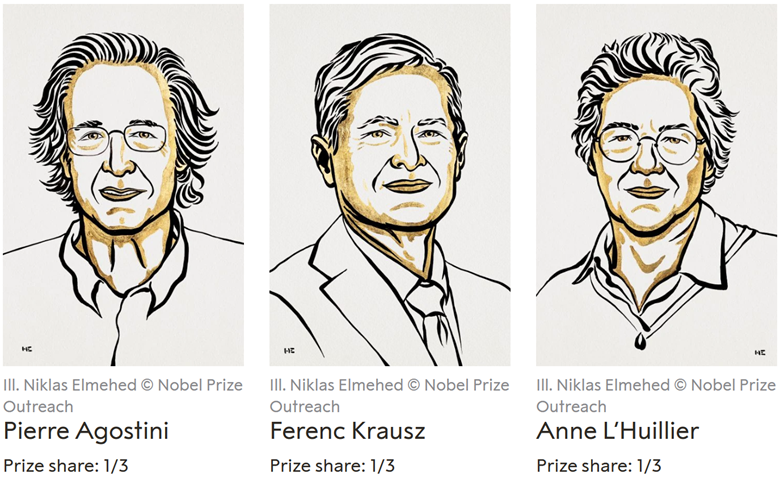2023 Nobel Prize in Physics: Generating the briefest flashes of light that illuminate electron motion in atoms and molecules
Assoc Prof Loh Zhi Heng | School of Chemistry, Chemical Engineering and Biotechnology, and School of Physical and Mathematical Sciences, NTU
The 2023 Nobel Prize in Physics was jointly awarded to Pierre Agostini, Ferenc Krausz and Anne L’Huillier “for experimental methods that generate attosecond pulses of light for the study of electron dynamics in matter”.

Image credit: https://www.nobelprize.org/prizes/physics/2023/summary/
The fascination with resolving timescales on which natural phenomena occur dates to the beginnings of human civilisation. The annual inundation of floodplains, the recurrence of lunar phases, and the trajectory of the sun across the sky from sunrise to sunset are examples of periodic processes that occur within the realm of human perception. In modern times, pushing the frontiers of science to elucidate phenomena that occur at speeds imperceptible to the naked eye has given rise to multiple Nobel Prizes – the 1967 Nobel Prize in Chemistry, to Manfred Eigen, Ronald Norrish and George Porter, for studies of “extremely fast chemical reactions”; the 1999 Nobel Prize in Chemistry, to Ahmed Zewail, for studies of “the transition states of chemical reactions using femtosecond spectroscopy”; and the 2018 Nobel Prize in Physics, to Donna Strickland and Gerard Mourou, for “their method of generating high-intensity, ultra-short optical pulses”. Prior to the pioneering studies conducted by the 2023 Physics Nobel laureates, however, the observation of the motion of the lightest subatomic particle – the electron – remained inaccessible. The motion of electrons in the microscopic realm occurs on the attosecond timescale, where one attosecond is 0.000000000000000001 seconds, or one billionth of a billionth of a second.

Image credit: https://www.nobelprize.org/uploads/2023/11/popular-physicsprize2023-1.pdf
The birth of attosecond science can be traced to 1987, when Anne L’Huillier and coworkers first observed a comb-like series of optical harmonics, reaching as high as the 33rd harmonic, produced by focusing intense laser pulses into a noble gas medium. Subsequent theories put forth to explain high-order harmonic generation (HHG), most notably the three-step model by Paul Corkum, suggest that these optical harmonics originate from the sub-cycle steering of electrons by the electric field of the intense driving laser, thus giving rise to attosecond flashes of light in the extreme ultraviolet. Pierre Agostini and coworkers devised a new measurement technique, the reconstruction of attosecond beating by interference of two-photon transitions (RABBITT), to show that the temporal structure of the high-order harmonics comprises a train of 250-attosecond pulses. By employing waveform-controlled laser pulses of few-cycle duration to drive HHG along with appropriate spectral filtering, Ferenc Krausz and coworkers successfully produced the first isolated attosecond pulses of 650-attosecond duration.
Attosecond metrology has opened the door to observing the fleeting spatial distributions and energies of electrons within atoms and molecules with unprecedented precision. Attosecond pulses have been used to investigate fundamental processes such as the decay of highly excited core-hole states, electron motion associated with quantum mechanical superpositions of valence electronic states, and time delays in the photoionisation of different atomic or molecular orbitals. In parallel, research on HHG has given rise to new tabletop sources of extreme ultraviolet and soft X-ray radiation for use in spectroscopy and imaging. The pioneering works of the 2023 Physics Nobel laureates will enable new discoveries and find many applications in physics, chemistry, biology, and materials science for the years to come.
For more information, watch the video accompanying the announcement of the 2023 Nobel Prize In Physics.







